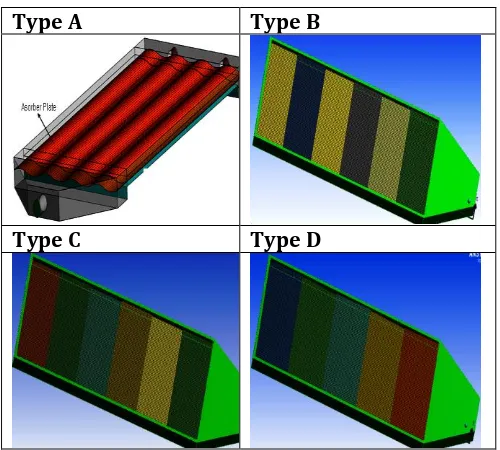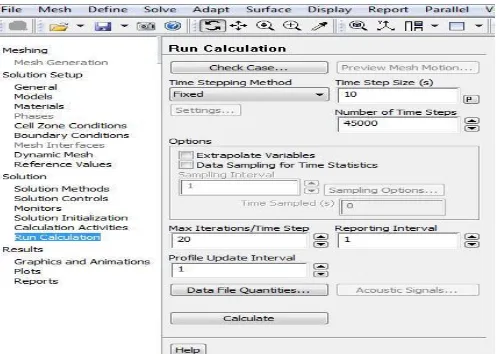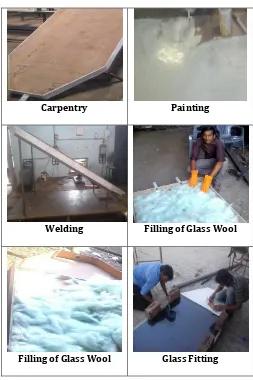© 2016, IRJET | Impact Factor value: 4.45 | ISO 9001:2008 Certified Journal | Page 1000
Design, CFD Analysis and Fabrication of Solar Flat Plate Collector
Prof. Kumavat Mukesh Manilal
Assistant Professor, Mechanical Engineering Department, SND COE & RC Yeola, Maharashtra, India
---***---Abstract –
This paper attempts to present numerical simulation of solar collector developed for drying food products and how to increase its efficiency. Solar drying is much feasible technically and economically. There has been a remarkable achievement in solar drying of food products due to sustained research and development associated with the adoption of advanced technologies.Simulation is an important tool for design and operation control. For designing of a collector plate, simulation makes it possible to find the optimum design and operating parameters. For the designer of the control system, simulation provides a means to device control strategies and to analyze the effects of disturbances.
In this paper, the Computational Fluid Dynamics (CFD) tool has been used to simulate the condition for different types of absorber plates having different shapes and configuration to obtain better efficiency than ordinary solar collector. The 3D model of the solar flat plate collector is modeled by UGS NX and then export in STEP format and then it is imported in ANSYS Workbench and then the meshing was created in ANSYS ICEM. The results were obtained by using ANSYS FLUENT software.
The objective of this work is to compare CFD solutions of different shapes of absorber plates for flat plate collector. The plate giving best result has been selected for fabrication. After fabrication, test was carried out and practical results were obtained. The results then compared with CFD analysis
Key Words:
Absorber Plates, Collector, CFD Analysis,
Drying Temperature, etc.
1. INTRODUCTION
1.1 Solar Flat Plate Collector
The major component of any solar system is the solar collector. A solar collector is a device designed to absorb incident solar radiation and to transfer the energy to a fluid passing in contact with it. Of all the solar thermal collectors, the flat plate collectors though produce lower temperatures, have the advantage of being simpler in design, having lower maintenance and lower operational
cost. Solar air heater is type of solar collector which is extensively used in many applications such as residential, industrial and agricultural fields. Solar collectors are the key component of active solar-heating systems. They gather the sun's energy, transform its radiation into heat, and then transfer the heat to a fluid (usually water or air). The solar thermal energy can be used in solar water-heating systems, solar pool heaters, and solar space-heating systems.
Flat-plate collectors are the most common solar collector for solar water-heating systems in homes and solar space heating. A typical flat-plate collector is an insulated metal box with a glass or plastic cover (called the glazing) and a dark-colored absorber plate. These collectors heat liquid or air at temperatures less than 80°C.
1.2 Objective
The objective of present study is to perform CFD simulation on four different types of absorber plate for solar collector. These results are to be compared and absorber plate giving best result is selected for fabrication. The results obtained by CFD simulation has to validate with experimental results. The experimental conditions taken for solar air collector, the same have been used for CFD simulation. The overall aim of this work is to increase the efficiency of flat plate solar collector.
2. PROBLEM STATEMENT
The main aim is to simulate the different shapes of flat plate collector and then fabricate the best model to validate the results.
© 2016, IRJET | Impact Factor value: 4.45 | ISO 9001:2008 Certified Journal | Page 1001
3. NUMERICAL MODELING OF SOLAR AIR
COLLECTOR
The procedure adopted to simulate the solar air collector by CFD tool is as follows:
[1] The 3D model has been modeled by using UGS NX software.
[2] Then it is imported in ANSYS.
[image:2.595.309.559.145.314.2][3] After importing 3D model, the meshing has been created by using ANSYS ICEM software as shown in Table 1
Table -1: 3D Meshing of Type of Absorber Plates
Type A
Type B
Type C
Type D
[4] The meshing created consist around 42 millions elements.
[5] The meshing which is created then imported in ANSYS FLUENT software and the experimental conditions are used while simulating the solar air collector.
Fig -1: General process in CFD
[6] The model was defined by using 3D segregated solver with steady condition, energy equation, and K-epsilon of viscous model.
Fig -2: Definition of Model for CFD
[7] The fluid chosen to simulate solar collector is air. The air properties used in this simulation is shown in table 2.
Table -2: Properties of air
Particular Mass flow rate
Density Thermal
Conductivity Specific Heat
Property 0.012 kg/sec
1.165
kg/m3 0.024 W/mK 1005 J/kgK
Fig -3: Properties of Air
[8] The glass properties used in this simulation is shown in table 3.
Table -3: Properties of glass
Particular Density Thermal
Conductivity Specific Heat Property 2489
kg/m3
1.75 W/mK 754
[image:2.595.37.287.261.486.2] [image:2.595.307.562.385.640.2]© 2016, IRJET | Impact Factor value: 4.45 | ISO 9001:2008 Certified Journal | Page 1002 Fig -4: Properties of Glass
[9] After setting all boundary conditions in fluent software, to solve the numerical equations the initialization by inlet is to be done.
Fig -5: Solution Methods
[10] To get the final results the numbers of iterations are set around 10000. The results for these simulations were converged at around 4000 to 6000 iterations.
Fig -6: Run Calculations
[11] As the number of elements is more to get the
converged results the time taken for these simulations will be more with single processor.
[image:3.595.36.289.86.266.2][12] Finally after getting the proper converged results the air flow distribution and heat transfer inside the solar air collector has been plotted in the form of Contour plots.
Table -4: Air Flow Distribution & Heat Transfer
[13] The outlet temperature has been calculated from ANSYS FLUENT after getting converged results and been compared with the experimental results.
[image:3.595.309.562.213.336.2]4. CFD RESULTS
Table -5: Temperature Distribution at 12 pm
Type A
Type B
[image:3.595.38.287.323.491.2] [image:3.595.293.555.440.668.2] [image:3.595.38.286.557.734.2]© 2016, IRJET | Impact Factor value: 4.45 | ISO 9001:2008 Certified Journal | Page 1003 Chart -1: Collectors outlet temp (oC) Vs time (hrs)
From above graph it is clear that absorber plate of type D gives better result than other types, so we have chosen type D for manufacturing solar flat plate collector.
[image:4.595.38.288.101.241.2]4.1 CFD RESULTS OF TYPE-D
Table -6: CFD Result of Type-D
Time Hrs
Ambient temp. (T1) (0C)
Outlet 1 Temp. (0C)
Outlet 2 Temp. (0C)
Avg. Temp. (T2)
9:00 AM 32 46.85 46.1 46.475
10:00 AM 36 65.87 66.6 66.235
11:00 AM 37 78.85 79.08 78.965
12:00 PM 38 102.88 100.2 101.54
1:00 PM 38.5 106.57 104.43 105.5
2:00 PM 39 104.86 101.81 103.335
3:00 PM 38 98.4 96.03 97.215
4:00 PM 38 89.84 86.73 88.285
5:00 PM 37 73.14 69.45 71.295
5:30 PM 35 61.41 57.53 59.47
6:00 PM 33 48.06 44.93 46.495
5. FABRICATION PROCEDURE:
Varies fabrication process were used to make flat plate collector. In carpentry shop wooden box is made. Baffles were inserted at inlet to divide air flow. Stand was made in drilling and welding shop. Stand body supporting wooden box was made by welding and fastened to wooden box. To make the collector easy for transportation legs were not welded instead they were drilled to facilate fastening so that they can be easily removed at the time of transportation. Absorber plate was made in sheet metal shop and then painted with black color.
[image:4.595.307.560.115.495.2]All the fabrication process is shown in table no. 7.
Table -7: Fabrication procedure
Carpentry Painting
Welding Filling of Glass Wool
Filling of Glass Wool Glass Fitting
6. RESULTS AND DISCUSSION
[image:4.595.34.294.358.540.2]6.1 PRACTICAL RESULTS OF TYPE-D
Table -8: Practical Result of Type-D
Time Hrs
Solar Intensity (W/m2)
Ambient temp. (T1) (0C)
Avg. Temp. (T2)
9:00 AM 603 32 45.5
10:00 AM 800 36 81.5
11:00 AM 998 37 92
12:00 PM 1015 38 98.5
1:00 PM 1047.5 38.5 101
2:00 PM 914 39 88
3:00 PM 845 38 79
4:00 PM 591 38 74
5:00 PM 500 37 60.5
5:30 PM 360 35 50
© 2016, IRJET | Impact Factor value: 4.45 | ISO 9001:2008 Certified Journal | Page 1004
6.2 COMPARISON OF EXPERIMENTAL AND
CFD
[image:5.595.35.292.164.414.2]RESULTS
Table -9: Comparison of Experimental and CFD Results
Time
(hr) Solar Intensity (W/m2)
Ambient temp. (0C)
Exp. outlet temp. (0C)
CFD outlet temp. (0C)
9:00 AM 360 32 45.5 46.475
12:00 PM 1015 38 98.5 101.54
3:00 PM 845 38 79 97.21
5:30 PM 603 35 50 59.4
Chart -2: Temperature Vs Time graph for Analytical and Experimental Result
7. CONCLUSIONS
We Know that food drying with the help of solar flat plate collector is more efficient than conventional process because it dries food at its optimum drying temperature without any contamination.
CFD analysis is a effective tool with which we can stimulate the models on various operating conditions without actually fabricating them and can compare their results. The best solution is then selected for fabricaton so that we can save time and money.
From CFD results and practical test performance, it is concluded that-
[1] Collector outlet temperature during day varies depending on solar intensity and it is directlly proportional with it.
[2] The best result is obtained on clear sunny days.
[3] CFD result values are higher than experimental values because there are some losses in actual practice. Also locally availabe materials have slightly different properties than as given in CFD stimulation.
8. REFERENCES
[1] V. Belessiotis , E. Delyannis, “Solar drying”, Solar Energy 85 (2011) 1665–1691.
[2] David Luna, Yves Jannot, Jean-Pierre Nadeau, “An oriented-design simplified model for the efficiency of a flat plate solar air collector”, Applied thermal engineering 30 (2010) 2808-2814.
[3] Khalil E.J.Al-Juamily, Abdul Jabbar N.Khalifa, Tadahmun A.Yassen, “Testing of the performance of a fruit &vegetable solar drying system in Iraq”, Desalination 209(2007)163-170.
[4] Basavanna S and K S Shashishekar, “CFD ANALYSIS OF TRIANGULAR ABSORBER TUBE OF A SOLAR FLAT PLATE COLLECTOR”, Vol. 2, No. 1, January 2013.
[5] C.T. Shaw, Using Computational Fluid Dynamics, Prentice Hall, 1992
[6]G. D. Rai, Solar Energy Utilization, Khanna Publishers, page no. 156-199, 5th Edition, Page no. 01-199.
[7] H.P.Garg,J.Prakash,Solar Energy Fundamentals & Application, Tata McGraw Hill,Page no. 01-113
[8] Sukhatme S. P., Solar Energy and Renewable Energy Source, Tata McGraw Hill, 2nd Edition, Page no. 01-196.
BIOGRAPHY
Mr. Kumavat Mukesh Manilal kumavatmukesh16@gmail.com BE Mechanical
SRES COE Kopaagaon (PUNE) ME Design



